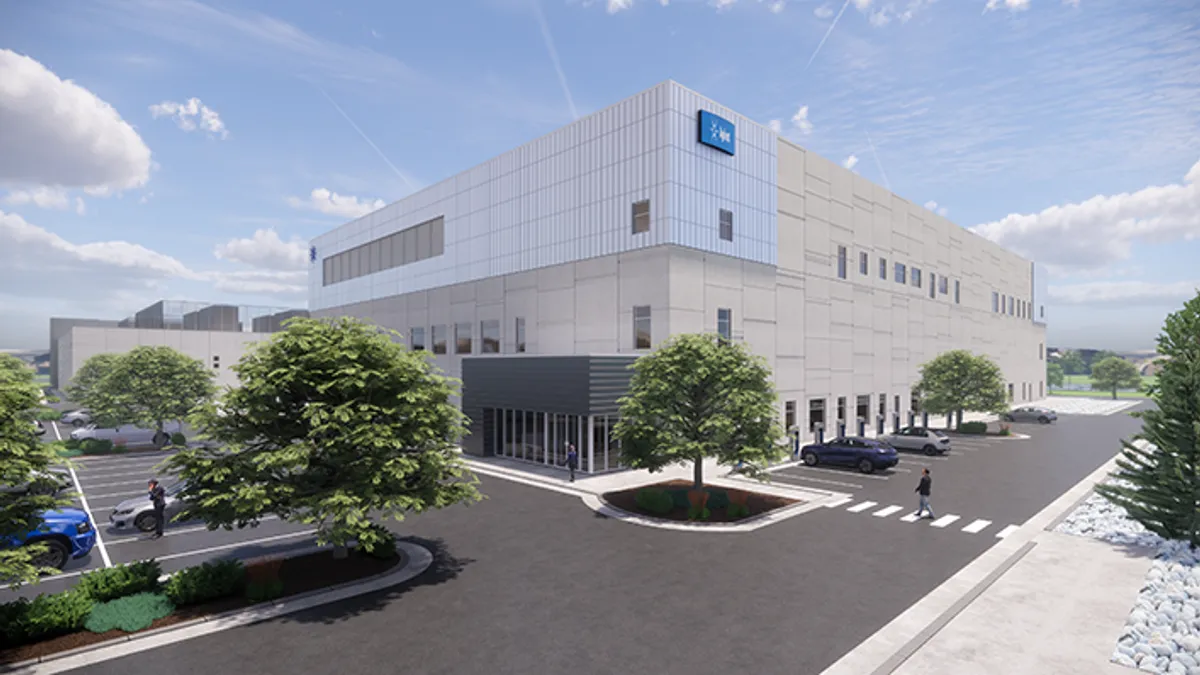Some are calling it the “modern day Industrial Revolution.”
But whatever name you give it, contractors are talking about how to take advantage of the current manufacturing construction boom, as dozens of factory projects go into planning or break ground in the U.S.
“We’re currently working on large-scale projects in the EV battery and consumer products sectors,” said Brent Strength, senior vice president at JE Dunn, a Kansas City, Missouri-based construction company. “The key to winning these projects centered around our unique early engagement process, tailoring it to their needs and laying out a detailed plan to drive value into the project’s budget and schedule.”

Manufacturing activity accounted for nearly 35% of year-over-year growth in overall construction spending in February, according to Anirban Basu, ABC chief economist. The sector was almost solely responsible for all nonresidential construction spending growth in February, reaching $140.67 billion, according to Associated Builders and Contractors.
Economists expect manufacturing projects to remain in high demand in the U.S. as more American companies push to onshore their facilities, largely due to the CHIPS Act. For example, manufacturing spending recently surpassed highway and street spending for the first time in more than 20 years, according to Census Bureau data. That’s even despite funding boosts from the $1.2 trillion Infrastructure Investment and Jobs Act.

Yet despite historic levels of activity in the space, unique complexities in manufacturing construction mean only a select few builders have the necessary expertise to participate in the sector’s boom.
“The mechanical, electrical and plumbing infrastructure, as well as the clean and dry room requirements, are unique for each project,” said Jim Brownrigg, senior vice president at New York-based Turner Construction. “It’s first having the core expertise to understand each of those, and then having the national and local resources to implement it.”

EV battery plant projects like the one that JE Dunn recently won in Tennessee, for example, move at a high velocity and are extremely intricate, even in comparison to some other advanced manufacturing projects, said Strength.
These projects require what are known as clean and dry rooms, which are airtight to maintain very low humidity levels and use particle filtration to ensure cleanliness. About 30% to 40% of the square footage of an EV battery facility will be clean and dry rooms, for example.
“Electrolytes, which go into every battery, are hazardous when they meet any moisture in the environment,” said Strength. “As a result, the manufacturing space for this material is a dry room that operates at less than 1% relative humidity and must be completely sealed.”
But that adds another layer of complexity during the construction phase.
In order to maintain that dry humidity level, mechanical, electrical and plumbing work is needed to drive dehumidification systems. Then the formation process, where teams charge, discharge and test batteries, creates heat and requires a lot of power.
“These projects have significant mechanical and electrical infrastructure,” said Brownrigg. “The uniqueness is the clean and dry room.”
There are also strict requirements for fire protection ratings for these spaces that require coordination, said Strength. Due to the highly specialized and sophisticated nature of the work, the pool of trade partners able to execute these projects is relatively small despite outsized demand in the space, he added.
“Mechanical, electrical and plumbing, along with sitework, concrete and steel, are the major components in the overall budget,” Strength said. “When they are involved early, trade partners can work alongside us, in a design-assist fashion, to fast-track design packages for long-lead equipment,” said Strength. That also helps keep costs down while securing labor for the project early, he said.
Planning nationally, acting locally
For example, Turner invested in a core group within its business several years ago to gain expertise in both the MEP and dry room infrastructure needed to build these facilities, said Brownrigg. With that core group, Turner then uses its local offices to capitalize on local resources and local market knowledge.
From there, Turner uses its scale – it’s the largest contractor by revenue in the country – to mobilize these projects, which tend to not be in major metropolitan areas, presenting tough labor challenges. For instance, Turner recently won awards to build a $725 million manufacturing facility in Frederick, Colorado, and a $4 billion EV battery manufacturing facility in De Soto, Kansas.
Brownrigg added that due to the sparse population around many of these projects, developing as many components as possible offsite has also been critical.
“We made a significant investment in offsite construction and in the mechanical, electrical and plumbing supply chain so that we can control our destiny,” said Brownrigg. “We’ve got to be able to flatten the labor curve as much as possible by doing offsite construction, because of the dynamic labor market today and the challenges there.”
Prefabrication can also help with controlling the supply chain for mechanical and electrical equipment, which is often the most critical path on these projects, Brownrigg said.
Likewise, Strength also listed offsite manufacturing as a critical component to get these projects across the finish line. On nearly all of JE Dunn’s manufacturing projects, the company prefabricated mechanical, electrical and plumbing components, he said.
Overcoming supply chain headwinds
Manufacturing facility projects have fast turnaround times, and that’s a problem due to the supply chain constraints that continue to plague the industry in the wake of the COVID-19 pandemic, said Strength.
“The best way to achieve speed to market is via the design-build delivery method,” said Strength. “Design-build allows us to mitigate supply chain issues by getting early release packages out even earlier, such as securing steel orders as early as possible.”
Then, JE Dunn can work with its design partners to formulate options, whether subbing in a different system, alternative materials, or other components that may be more readily available.
Another challenge is the evolution toward more sustainable design and operations. That requires a true understanding of low carbon approaches, how to effectively remove fossil fuels and how that will impact equipment requirements, said Brownrigg.
“There’s a race going on in this country with the modern day Industrial Revolution around the space,” said Brownrigg. “Everybody’s trying to get to market first.”





















